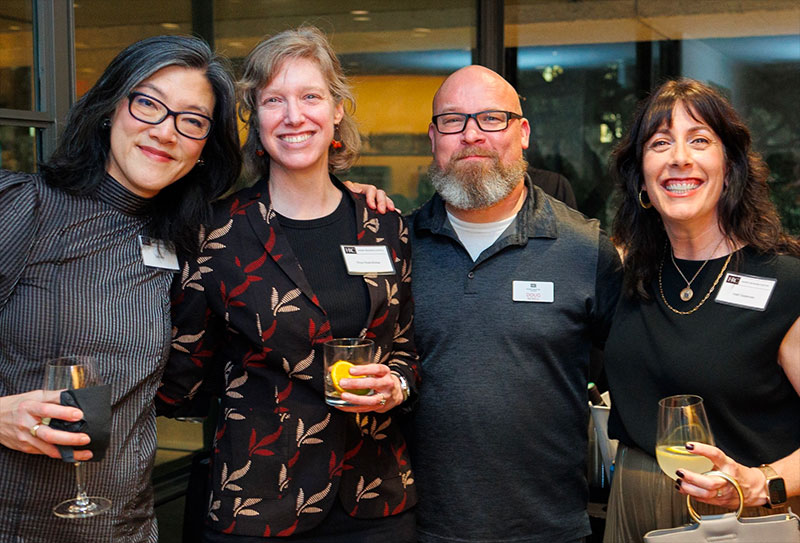
After an extensive search, the Harry Ransom Center is pleased to welcome Dr. Erica Nunn-Kinias (second from left in photo) as the Center’s Associate Director of Exhibitions and Public Programs. Nunn-Kinias comes to the Center from Colorado, where she was Program Director for the Gallery and Museum Management Masters at Western Colorado University. She previously served as a Curator at Chiddingstone Castle in the United Kingdom and as Executive Director of the Telluride Historical Museum. Ransom Center Director, Stephen Enniss, noted it was the combination of her intellectual curiosity and her practical knowledge of museum practice that made her stand out. “My colleagues and I look forward to working with Erica to advance the Ransom Center’s reach and impact on campus and far beyond it.”
…what I’m passionate about…is making research and collections, not just accessible, but interesting, engaging, relevant and fun.
—ERICA NUNN-KINIAS
In addition to her museum work, Nunn-Kinias received a PhD. in History of Art from Brown University, focusing on the architecture of medieval nunneries in France. But the early modern manuscripts collection isn’t the only collection she’s excited to work with when she arrives. “My research expertise is medieval and early modern, so I’m really interested in the manuscript collections,” she said. “But I’m an art historian. So I’m excited about learning. I think the process of learning more, or learning something new about the collections can help me translate that in programming and exhibition ideas, or for an audience, that also is not a specialist. So that learning process with finding things I don’t know about is part of what makes the job exciting. But yes, I can’t lie that I’m not excited about digging into some of the early modern manuscript collections.”
The opportunity to work with a collection that is accessible to researchers, students, and the community alike was one of the reasons she was drawn to the role. When she arrived last fall to visit the campus, she experienced that firsthand. “The enthusiasm of the people who worked at the Center was just infectious. And I realized that this is a place that didn’t just say it had a world-renowned collection, and sat on their laurels, right, it was active and dynamic and outward facing institution. And that, to me, is a sign of a really healthy and exciting place to work. So it’s what I’m passionate about, which is making research and collections, not just accessible, but interesting, engaging, relevant and fun.”
One of the ways Nunn-Kinias will seek to make the Center’s collections engaging and relevant is by connecting with the people of Austin. “Austin just seems like a fabulous kind of melting pot in a good way. I’m interested to learn more about the different religious and linguistic communities. More about the nonprofits that serve them, and how can we build on those relationships or partner expand or forge new ones. Why can’t we talk more about food, and music, and research? If those are things that our city celebrates, why can’t we find a match for that and celebrate that and what we do?”
When envisioning an exhibition and the way audiences will be interacting with it, Nunn-Kinias is interested in finding methods to convey the process alongside the final product. “I’ve been really interested lately in the process of making art, or putting together bound manuscripts. I love looking at the final product. But I love learning more about the people and the materials that they use to build or construct what we’re looking at, like, I’m really interested in process. I want to know why, I want to know who did this, what were they wearing? Where did they live, more about them as people…it’s a whole network of exchange and movement, and trade. So that would be something that I think would be interesting: an exhibition that focuses on process and materials, and the people behind what we’re looking at. Because I think in the end, what we connect with is other people.”
When she arrives, Nunn-Kinias will be new to the city. In order for staff and friends of the Center to better help her acclimate, she shared some of her hobbies and interests. “I love to eat…so different restaurants, small restaurants, food trucks, places to go. I’m also a big reader — Literary festivals, fun things to do. I try to be as extroverted as possible, because my tendency is just to sit inside my house and read and watch documentaries. So yeah — film culture,” she said.
Nunn-Kinias begins her role as Associate Director of Exhibitions and Public Programs on February 12.